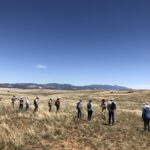NEPA: National Environmental Policy Act
What is a Plan of Operation and What’s a Scoping Notice?
If you don’t know the answers to these questions, the first step you can take is to familiarize yourself with the National Environmental Policy Act (NEPA). The Council on Environmental Quality (CEQ) has written a very easy-to-read Citizens Guide to NEPA. We recommend that you read it; it has been an invaluable resource for us, and we refer to it often.
NEPA as it applies in our situations:
Once a mining company submits a Plan of Operations for their proposed mining activities on Forest Service lands, the US Forest Service will then issue a Scoping Notice to the public.
Scoping is part of the procedures by which the lead agency (USFS) identifies important issues and determines the extent of analysis necessary for an informed decision on a proposal.
Scoping is part of the public involvement process. The issuance of a Scoping Notice marks the beginning of a public comment period, which most commonly lasts for 30 days. With NEPA, this is our first opportunity for citizens to voice our concerns, and in the case of a categorical exclusion, it may be our only opportunity.
Mining projects get categorized in one of three possible ways:
Projects without significant environmental impacts: “Categorical Exclusions”
A categorical exclusion (referred to as ‘CE’ or ‘Cat Ex’) is a category of actions established by each agency (i.e. USFS) that are exempted from the NEPA requirements to prepare a “detailed statement” on the impacts because they are considered to not have a significant effect on the human environment, either individually or cumulatively.¹
A proposed action may be categorically excluded from preparing a “detailed statement” on the impacts only if it fits into certain categories and “if there are no extraordinary circumstances related to the proposed action.”
Writing NEPA Scoping Comments: Categorical Exclusions
Projects with anticipated environmental impacts: “Environmental Assessments” and “Environmental Impact Statements”
(NEPA) requires a “detailed statement” on the impacts of any proposed action that may “significantly affect the quality of the human environment.”²
This “detailed statement” can take one of two forms:
-
- Environmental Assessment (EA), a brief analysis used to determine the significance of impacts resulting from a federal action.
- Environmental Impact Statement (EIS), a detailed and thorough analysis used for those actions that are expected to result in significant impacts.
Writing NEPA Scoping Comments: EA or EIS projects
Commenting on a Draft Environmental Assessment
The purpose of a draft Environmental Assessment is to determine whether a project will have SIGNIFICANT effects.
- If they are, then the Forest Service must prepare a more detailed Environmental Impact Statement (EIS) rather than an Environmental Assessment (EA). When deciding whether the impacts are “significant” NEPA implementing regulations (40 CFR § 1508.27) require that agencies consider both:
- Context: The significance of an action must be analyzed in several contexts such as society as a whole, the affected region, the affected interests, and the locality. Significance varies with the setting of the proposed action. For instance, in the case of a site-specific action, significance would usually depend upon the effects in the locale rather than in the world as a whole. Both short- and long-term effects are relevant.
- Intensity: This refers to the severity of impact.
Tips for writing comments on draft Environmental Assessments
Other Online Resources:
- Citizen’s Guide to NEPA (Council for Environmental Quality (CEQ) Regulations for Implementing the National Environmental Policy Act (40 CFR 1508.4) Available online at: http://ceq.hss.doe.gov/publications/citizens_guide_to_nepa.html
- Council for Environmental Quality (CEQ) Regulations for Implementing the National Environmental Policy Act (40 CFR 1508.4). Available online at: nepa.gov/ceq_regulations/regulations.html
- USFS NEPA Handbook. Available online at: http://www.fs.fed.us/emc/nepa/nepa_procedures/
- Guidebook for Evaluating Mining Project EIAs. Environmental Law Alliance Worldwide. Available online at: http://www.elaw.org/mining-eia-guidebook
- The Role of Controversy in NEPA: Reconciling Public Veto with Public Participation in Environmental Decisionmaking. By William Murray Tabb of William & Mary Environmental Law & Policy Review. Available online at: http://scholarship.law.wm.edu/wmelpr/vol21/iss1/4
- What do all those acronyms mean??? Check out our handy Glossary of Terms!
—————————————–
¹ Council for Environmental Quality (CEQ) Regulations for Implementing the National Environmental Policy Act (40 CFR 1508.4). Available at nepa.gov/ceq_regulations/regulations.html
²National Environmental Policy Act (NEPA), 42 USC § 4332(C) (1982).










